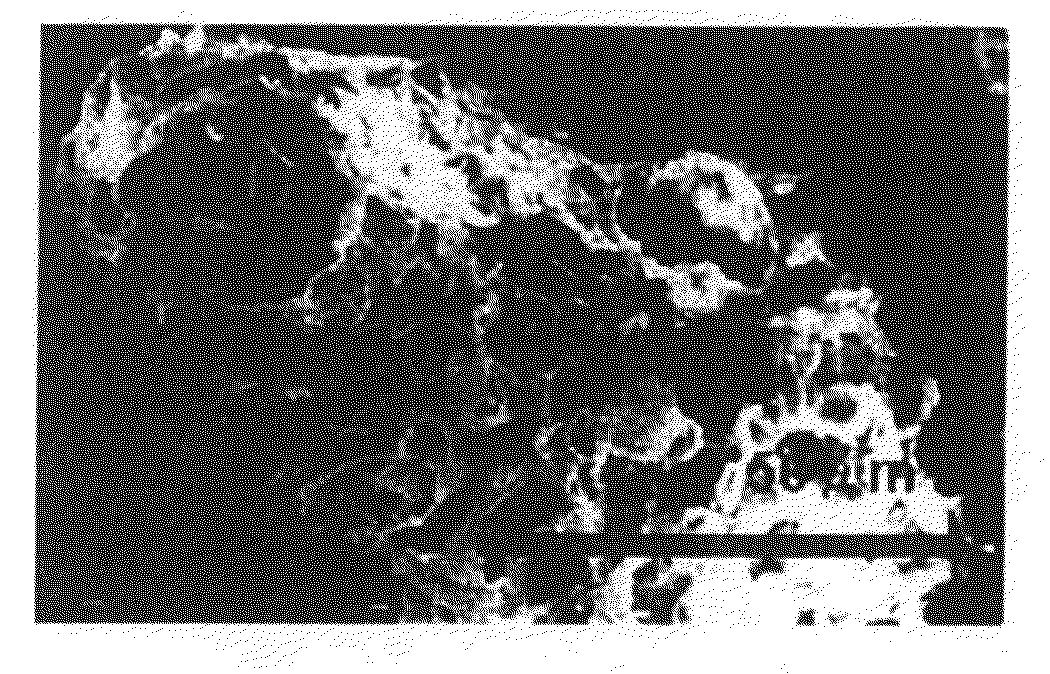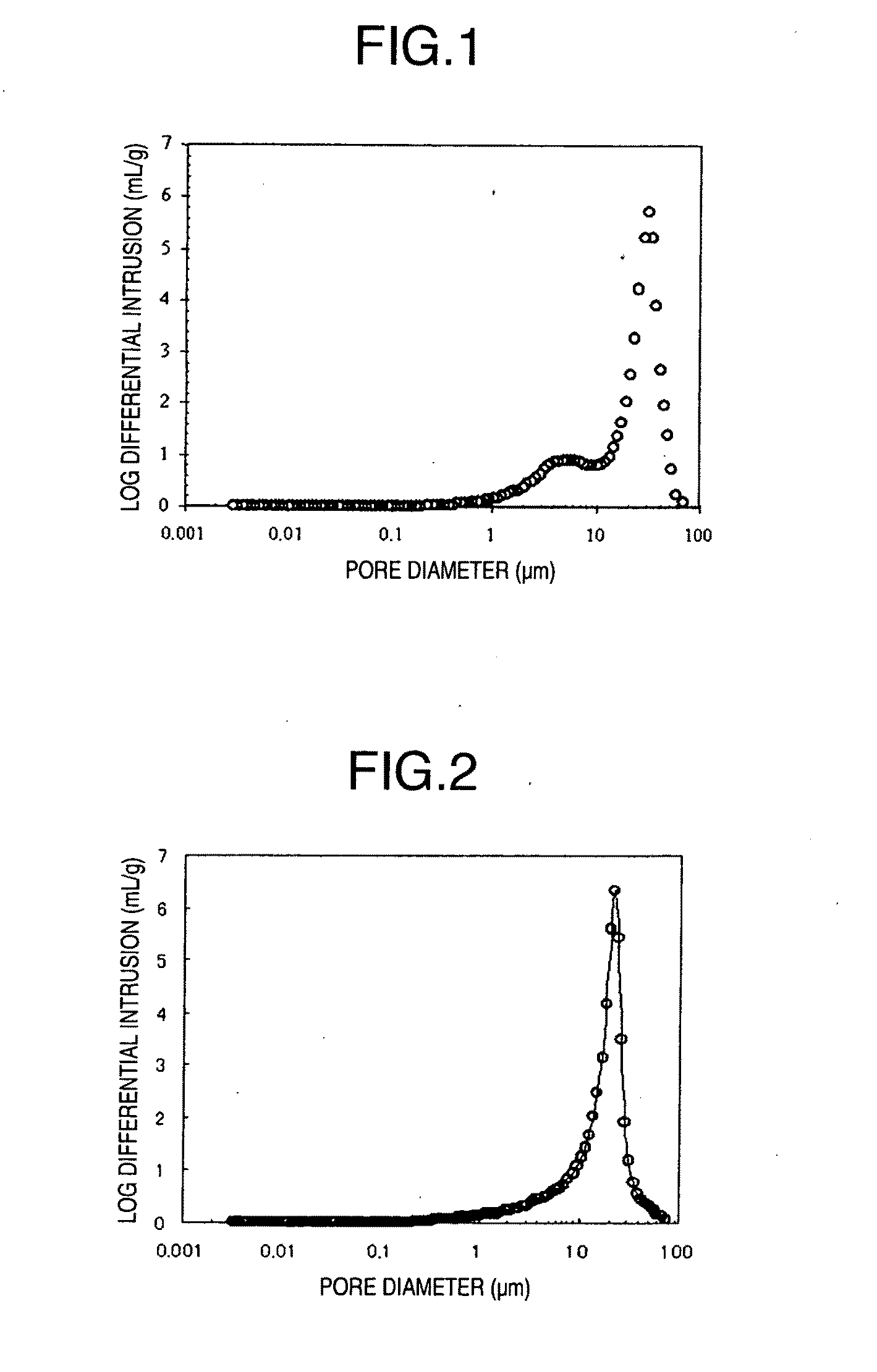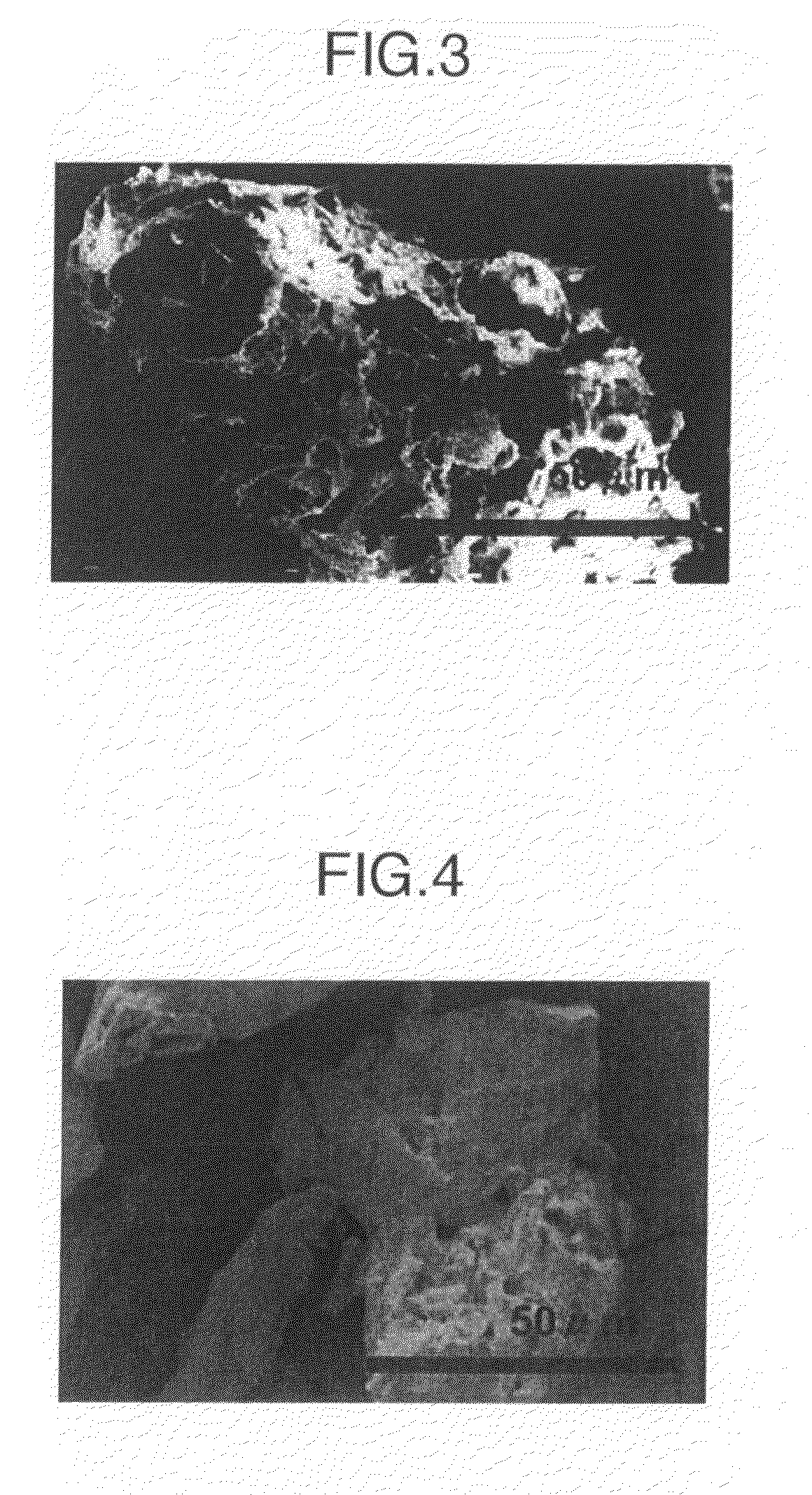It is described that with a larger median
pore diameter, there is better disintegration property, but it is speculated that in practice it is difficult to obtain a large median
pore diameter of 3 μm or larger by the production method according to the
Patent Document.
Although the cellulose particle in
Patent Document 2 is superior in its fluidity, the tight continuous cellulose wall is impermeable to water, so that the cellulose particle was not disintegrated in water, and sometimes the rapid release of an
active ingredient was impeded.
Further, the cellulose particle of Patent Document 2 is poor in its plastic deformation and has insufficient compactability while the cellulose is compressed, and furthermore since an
organic solvent and a third component, which is a crystalline compound soluble in the
organic solvent, are used during the production process, not only the production cost is high but also the
active ingredient can be inactivated.
Thus it is insufficient to be used stably as an
excipient.
Further, the pore volume itself of the cellulose particles of Patent Document 3 is large, but since the particle structure is different from that of the porous cellulose aggregates of the present invention, water
permeation into the particles is difficult, and there is a problem of the inferior disintegration property.
In addition, since an
organic solvent is used for these porous cellulose aggregate particles during the production process, not only is the production cost high but also the active ingredient can be inactivated because the specific surface area is too large and the interaction between the active ingredient and water is promoted.
Thus it is insufficient to be used stably as an excipient.
For that reason, these
cellulose powders have a small specific surface area of 0.6-1.2 cm3 and poor compactability.
These publications disclose the control of the compactability, fluidity and disintegration property of cellulose particles by adjusting the apparent
specific volume, but there were problems that in the range of relatively small apparent
specific volume of 2.0-2.9 cm3 / g, the fluidity and disintegration property were good but the compactability was unsatisfactory, while with larger apparent
specific volume of 3.0-3.2 cm3 / g, the compactability was good but the fluidity and disintegration property were poor.
Although this
glucan powder has good compactability, it has problems that the disintegration property is poor and the fluidity is inferior due to the small average particle size.
Although the cellulose
powder of Patent Document 7 is described to have good compression compactability and disintegration property, the best balanced Example that is disclosed specifically is measured to have a repose angle of over 55° and the fluidity is not satisfactory enough.
There was a problem that in formulations, in which an active ingredient having poor fluidity was used in large proportion, the variation coefficient of tablet weight was larger thereby influencing uniformity of the
drug content.
Further, when compacting (molding) was performed under
high pressure using the cellulose powder according to the document, a high
hardness can be obtained but there was a problem of delayed disintegration because there is no intentionally formed intraparticular pore, and water permeability to inside of the particle was low.
For example, when continuous compression was performed at high speed in a formulation in which an active ingredient having poor fluidity was mixed in a large proportion, the variation coefficient of tablet weight was getting larger, thereby influencing uniformity of the
drug content, and thus satisfactory result was not obtained in terms of fluidity.
Further, when compacting (molding) was performed under
high pressure using the cellulose powder according to these publications, high
hardness can be achieved but there was a problem of delayed disintegration because there was no intentionally formed intraparticular pore, and water permeability to the inside of particle was low.
For example, when continuous compacting (molding) was performed at high speed in a formulation in which an active ingredient having poor fluidity was mixed in a large proportion, the variation coefficient of tablet weight was increased, thereby influencing uniformity of the
drug content, and thus satisfactory result was not obtained in terms of fluidity.
Further, when compacting (molding) was performed under
high pressure using the cellulose powder according to the document, high
hardness can be achieved but there was a problem of delayed disintegration because there was no intentionally formed intraparticular pores, and water permeability to the inside of particle was low.
In the range of 2.3-6.4 cm3 / g of the apparent specific volume for the
cellulose powders described in these Patent Documents 6-9, and in the range of over 7 cm3 / g of the apparent specific volume for the
cellulose powders described in Patent Document 10, sufficient compactability was obtained in each case but there was a problem that the fluidity and disintegration property were deteriorated.
The cellulose particles described in these documents do not form a secondary
aggregate structure, and the celluloses obtained by the method of Examples described in Patent Documents have an apparent specific volume of 2.5 cm3 / g or lower, nearly spherical shape and good fluidity but are poor in compression compactability, and under the commonly used
compression pressure of 10-20 MPa, a molded body which has sufficient hardness for practical use can not be made.
On the other hand, since the cellulose particles described in Patent Documents 4-9, and 11-14 do not have intraparticular pores that are intentionally formed, and pore volume within a particle is small, almost no active ingredient can be held in the particles and therefore there have been problems of liquid components bleeding out in compression compacting (molding) and problems in tablet press operation.
Also, the cellulose particles described in Patent Document 2 and 3 have intraparticular pores, but the
pore diameter is small, and therefore it is difficult for water to permeate into the dense and continuous cellulose wall, which imposes problems that the cellulose particle does not disintegrate in water and quick release of an active ingredient is hindered.
Furthermore, since these cellulose particles do not have intraparticular pores that are intentionally formed, and the pore volume within a particle is small, almost no active ingredient can be held in the particles, and thus they have a shortcoming that in
solid formulation of an active ingredient that is hard to be soluble in water, the formulation can not be practically used due to slow
elution of the active ingredient, unless complicated processes are performed such as temporary
granulation with water or an organic
solvent,
drying and the like.
They also have a shortcoming that in
solid formulation of an active ingredient that tends to sublimate, the active ingredient re-crystallizes during storage, ruining their commercial value.
This method needs a long time for
grinding treatment until crystalline characteristics of β-1,4-
glucan powder are lost, and also powerful shear must be applied continuously for a long time using a roll mixer, thus creating a problem of poor efficiency in the actual production process.
Further, β-1,4-
glucan powder that has lost the crystalline characteristics has a problem of poor compression compactability.
Furthermore, since a surfactant has to be added to facilitate the
elution of the active ingredient that is hard to be soluble in water, there is a problem that when this
solid formulation was administered, the surfactant caused
inflammation of the
mucus membrane of the
digestive tract.
Still further in such a method, many steps are essential for
drying and there are problems of the cost related to the equipment, and that the
energy cost for
drying is high.
Also, there are problems that this method cannot be applied to an active ingredient inactivated by heat and the like problems.
However, Example of this Patent Document uses cellulose particles having excessively high specific surface area and the active ingredient absorbed on the surface by sublimation is amorphous and therefore there is a problem of storage stability because during the storage a part of the active ingredient is crystallized and the
elution rate is changed, and in a tightly bound compacting composition such as a tablet, there is a shortcoming that the elution of the active ingredient is slow because its disintegration is impeded due to the poor disintegration property.
However, even with such treatments, there are problems that the active ingredient bleeding out of the formulation through the film layer causes low uniformity of the active ingredient content in the formulation, the active ingredient attached to the surface of the formulation gives irritating smell when taking the formulation or re-crystallizing in a preserving container such as a
vial greatly reduces the commercial value.
As already described above, in Patent Document 18 cellulose particles having excessively high specific surface area was used, and since the active ingredient absorbed by sublimation on the surface was amorphous, there was a problem of poor storage stability of the active ingredient, and in a tightly bound compacting composition such as a tablet, there was a shortcoming that the elution of the active ingredient was slow because its disintegration was impeded due to the poor disintegration property.
In the past, a composition containing an active ingredient that was oily, liquid or
semi solid at normal temperature had problems compared to a solid active ingredient that it is especially prone to tablet pressing problems due to the liquid component bleeding out from the formulation, spots of the liquid component are produced on the surface of the formulation, and in the case of granular formulation, inferior fluidity occurred.
These problems not only markedly lower the quality of the product but also cause the low uniformity of the concentration and effect of the active ingredient, and thus improving these problems is a very important task.
However, by the methods of these Patent Documents, the active ingredient that is liquid or semisolid at normal temperature effuses out at the time of compression, causing tablet pressing troubles, and sometimes satisfactory compression molded body may not be obtained.
Still further, in the method described in Patent Document 20-31 many steps are essential for drying and there are problems that the cost related to the equipment, and the
energy cost for drying is high.
 Login to View More
Login to View More 


